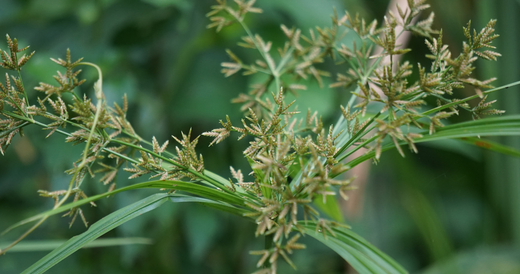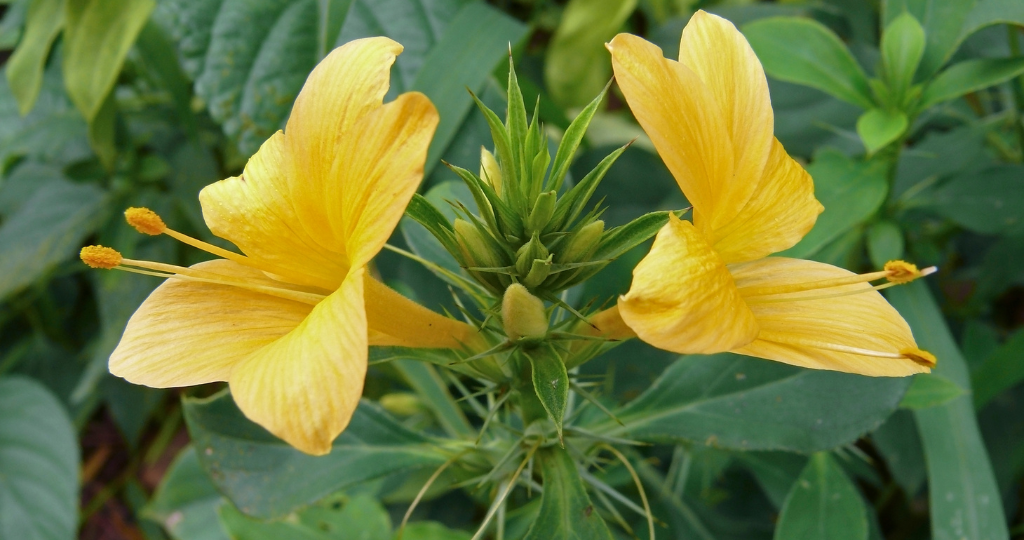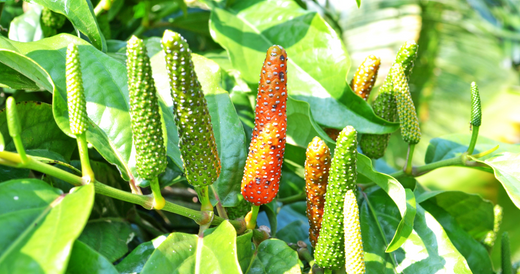An Introduction to Nagarmotha
Nagarmotha (scientifically known as Cyperus rotundus or nut grass) packs some strong healing properties. For ages, people have used the sweet-smelling tuber-like parts that grow under the soil (called rhizomes) of this plant to treat tummy troubles, fevers, infections, painful periods, and more.
- Hindi Name: Nagarmotha
- Sanskrit Name: Mustaka
- English Name: Nut Grass
- Latin Name: Cyperus rotundus Linn
10+ Evidence-Based Advantages of Nagarmotha Herb
- Nagarmotha rhizomes exhibit anti-inflammatory actions by inhibiting inflammatory proteins linked to conditions like arthritis.
- Nagarmotha demonstrates antimicrobial effects against common bacteria and fungi
- The liver-protective abilities of Nagarmotha mitigate toxin-induced liver injury through antioxidant and membrane stabilisation mechanisms.
- Nagarmotha has analgesic and muscle relaxant properties related to pain relief, supporting the Ayurvedic application for painful menstrual cramps.
- Nagarmotha exhibit larvicidal effects against mosquitos
- Nagarmotha extracts helps regulate blood sugar levels and manage symptoms in diabetic patients
- Nagarmotha has potential anti-cancer benefits
- Nagarmotha protects against chemically induced stomach ulcers
- Nagarmotha extracts promote wound healing

Source: Canva
1. Nagarmotha Calms Inflammation
The rhizomes contain compounds that act like natural inflammation fighters in the body. They work by blocking certain proteins that promote chronic swelling in conditions like arthritis. Less inflammation equals less joint pain.
2. Nagarmotha Fights Germs
Traditional healers have long used nut grass to beat bacteria and fungi, causing hard-to-kick infections. Extracts in the lab can wipe out some common microbial troublemakers that trigger skin, digestive, and urinary woes.
3. Nagarmotha Supports Liver Health
Your hardworking liver takes daily hits from toxins in food, water, air, medicines, etc. Nagarmotha's antioxidants and membrane guards can protect liver cells from chemical damage.
4. Nagarmotha Eases Menstrual Cramping
For women plagued by debilitating menstrual cramps, Nagarmotha has proven power to dial down pain meaningfully. It works directly on compounds that cause cramping and smooth muscle spasms.
5. Nagarmotha Repels Mosquitos
If you're tired of summer nights swatting and scratching bug bites, Nagarmotha could help you bug off! The rhizome oils naturally deter mosquito larvae from growing up to terrorise us.

Source: Canva
6. Keeps Blood Sugar in Check
Managing diabetes can feel like a non-stop rollercoaster, constantly having to adjust food, activity, and medications to control those pesky blood glucose levels. Chugging nut grass extracts may help smooth out some spikes and drops. Moreover, Nagarmotha supplements help better regulate insulin and sugar metabolism in the long term. It could make for a less nerve-wracking ride.
Other Plants
- Vajradanti herb & it's importance in Ayurveda
- Pippali herb & it's importance in Ayurveda
Soothing Stomachs
If you’ve ever felt the searing stomach pain and burning of ulcers, you understand why healing them faster is a top priority. Turns out traditional Ayurvedic healers already knew a trick for that—Nagarmotha tea! Researchers found the rhizome broth effectively protects rat stomach linings from ulcer-forming chemicals. The combo of potent antioxidants and inflammation-dampening action likely underlies the gastroprotective effects that fasten healing.
Sealing Skin Wounds
Minor scrapes and scratches can be annoying, but severe skin trauma from burns, wounds or surgeries poses higher risks for infection and permanent scarring. Topically applying Nagarmotha extracts early on jumpstarts the intricate tissue repair steps for faster wound closure with less scarring.
Nutrition Facts of Nagarmotha
This ancient underground stem delivers a one-two punch of vital nutrients we need more of - antioxidant flavonoids and tannins to beat cellular damage fueling disease plus essential minerals like iron, zinc and copper that keep immunity strong, energy up, hormones balanced day to day.
|
Essentials Components |
Purpose |
|
Flavonoids |
Antioxidants that counter cell damage; anti-inflammatory, anticancer and neuroprotective effects |
|
Terpenoids |
Antimicrobial,anticonvulsant,antioxidant,anticancer effects |
|
Alpha-cyperone |
Analgesic, anti-inflammatory, and relaxant properties to ease pain |
|
Calcium |
Critical for bone health, nerve and muscle function, immune regulation |
|
Camphene |
Antimicrobial and anti-inflammatory properties |
|
Oleic acid |
Anti-inflammatory action; cardiovascular protector |
|
Patchoulenone |
Antiemetic, anti-inflammatory, and analgesic indole alkaloid |
|
D-Fructose |
Natural sugar that provides energy may have gastroprotective effects |
|
Beta-rotunol |
Sedative compound with analgesic and antispasmodic muscle relaxant properties |
How Does Nagarmotha Work for Health Issues?
The healing mechanisms of the Nagarmotha plant are complex but center around two primary modes of action. Firstly, as an anti-inflammatory agent. The flavonoids, tannins, and other bioactive compounds abundantly found in Nagarmotha rhizomes work to reduce the kind of chronic, systemic inflammation underlying many illnesses. This inflammation-dampening ability provides widespread benefits across conditions, including arthritis, IBS, endometriosis, and metabolic disease.
Secondly, Nagarmotha functions as a disease fighter. Its antioxidant and antimicrobial components - from terpenes to piperine alkaloids - combat factors promoting chronic disease on a cellular level. From neutralising free radicals that drive ageing to wiping out harmful microbes behind infection, these protectors shore up the body's defences.
Other Herbs
Top Ways You Can Use Nagarmotha
- Churna
- Kwath
- Gutika
- Lehyam
- Rasa
- Tailam

Source: Canva
Top Vajradanti Myths & NagarmothaFacts
Here are presenting the myths and facts associated with Nagarmotha:
Facts About Nagarmotha
- Though often called nut grass, Nagarmotha belongs to the sedge plant family.
- Under the ground, its rhizome stems can grow over 6 feet down, making it very sturdy.
- Traces of Nagarmotha were found in ornate Indian gold pots dating back to 500 BC.
- Hard rhizomes allow Nagarmotha to thrive despite flooding, droughts
- Nagarmotha happily grows everywhere - Asia, Africa, Americas - not easily contained
- Oils providing its healing powers also make rhizomes taste very bitter alone.
- Ancient Hindu texts link Nagarmotha to Parvati - a divine cosmic connection.
Myths About Nagarmotha
- Nagarmotha is bad for crops
- It’s illegal to grow Nagarmotha
- Touching the plant causes leprosy
- Nagarmotha is native to India
Conclusion
Nagarmotha, also known as Nut Grass, is a potent Ayurvedic herb with a rich history of therapeutic uses. From aiding digestion to promoting skin health, its versatility makes it a valuable addition to holistic well-being. Moreover, incorporating Nagarmotha into one's lifestyle offers a natural path to balance and vitality, connecting us to ancient healing traditions for a healthier, harmonious life.
FAQs
1. What are some traditional uses of Nagarmotha in Ayurvedic medicine?
Nagarmotha rhizomes is used traditionally to treat digestive issues like gas and bloating, infections, painful menstrual cramps, fevers, and more.
2. How does Nagarmotha help with painful menstrual cramps?
According to the content, Nagarmotha has analgesic and muscle relaxant properties that provide relief from muscle spasms and pain compounds causing debilitating menstrual cramps.
3. What essential minerals does Nagarmotha provide?
As per the nutrition facts table, Nagarmotha supplies essential minerals like calcium, iron, zinc, copper, potassium and phosphorus that play critical roles in bone health, enzyme function, tissue growth, and more.
4. What health conditions can Nagarmotha help manage?
Some of the key health conditions the content indicates Nagarmotha may help with include arthritis, diabetes, stomach ulcers, poor wound healing, pain disorders, and even shows potential anti-cancer effects.
5. Where does Nagarmotha naturally grow?
The facts shared reveal that Nagarmotha grows widely across tropical and temperate parts of Africa, Asia, and the Americas, thriving both wild and under cultivation.







